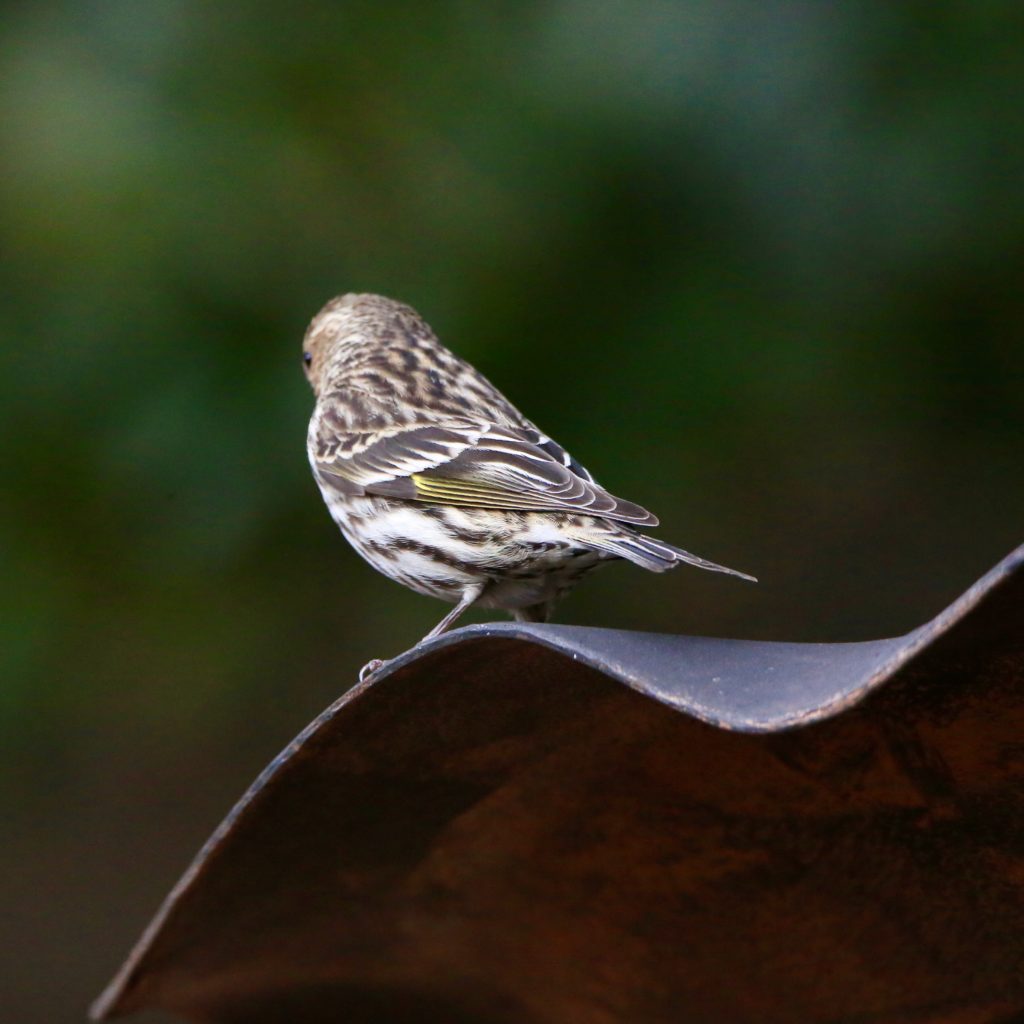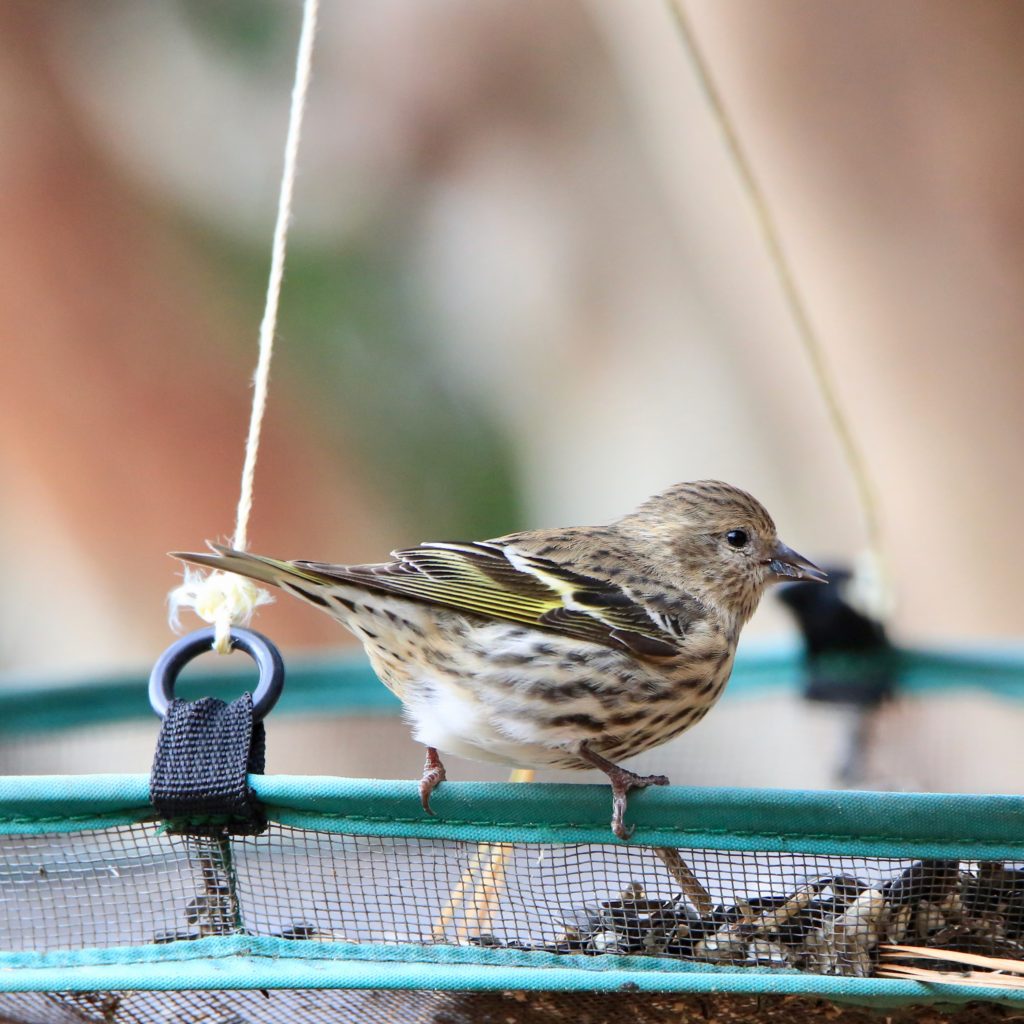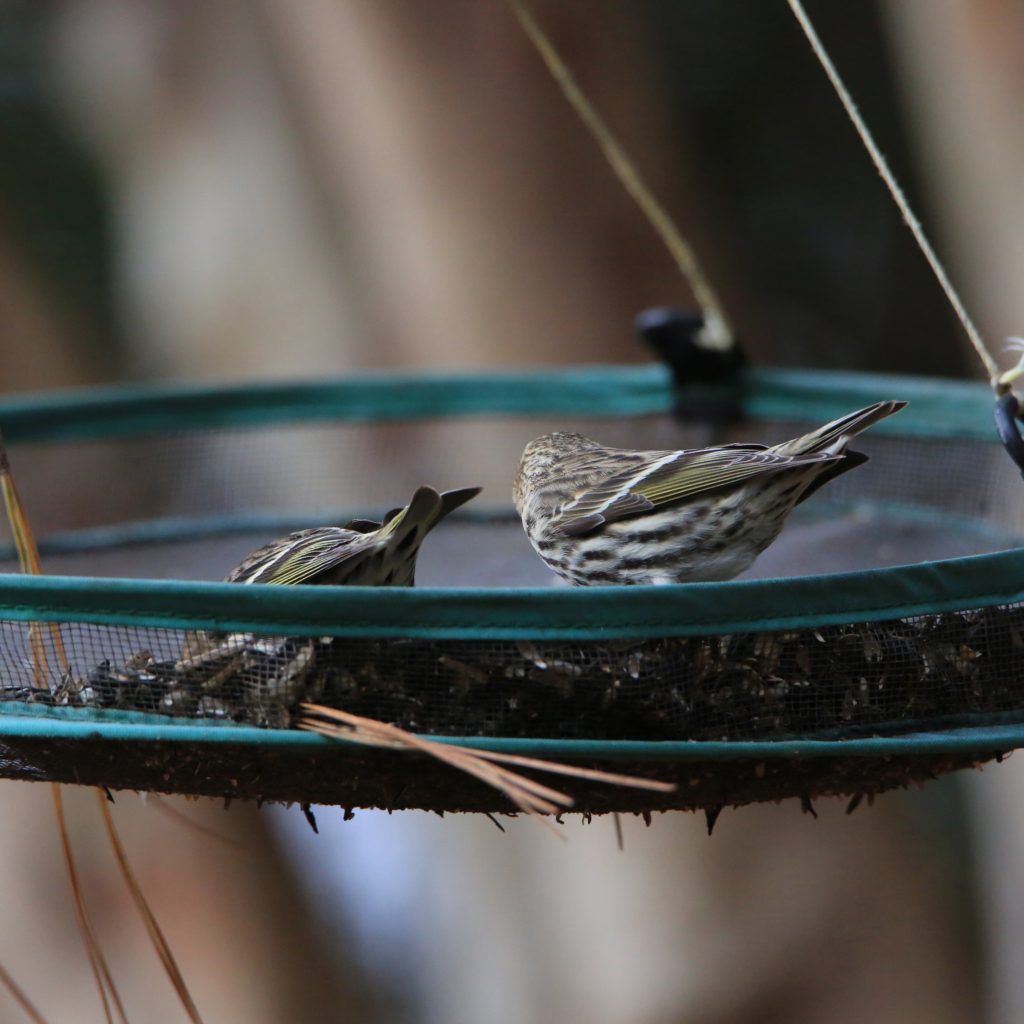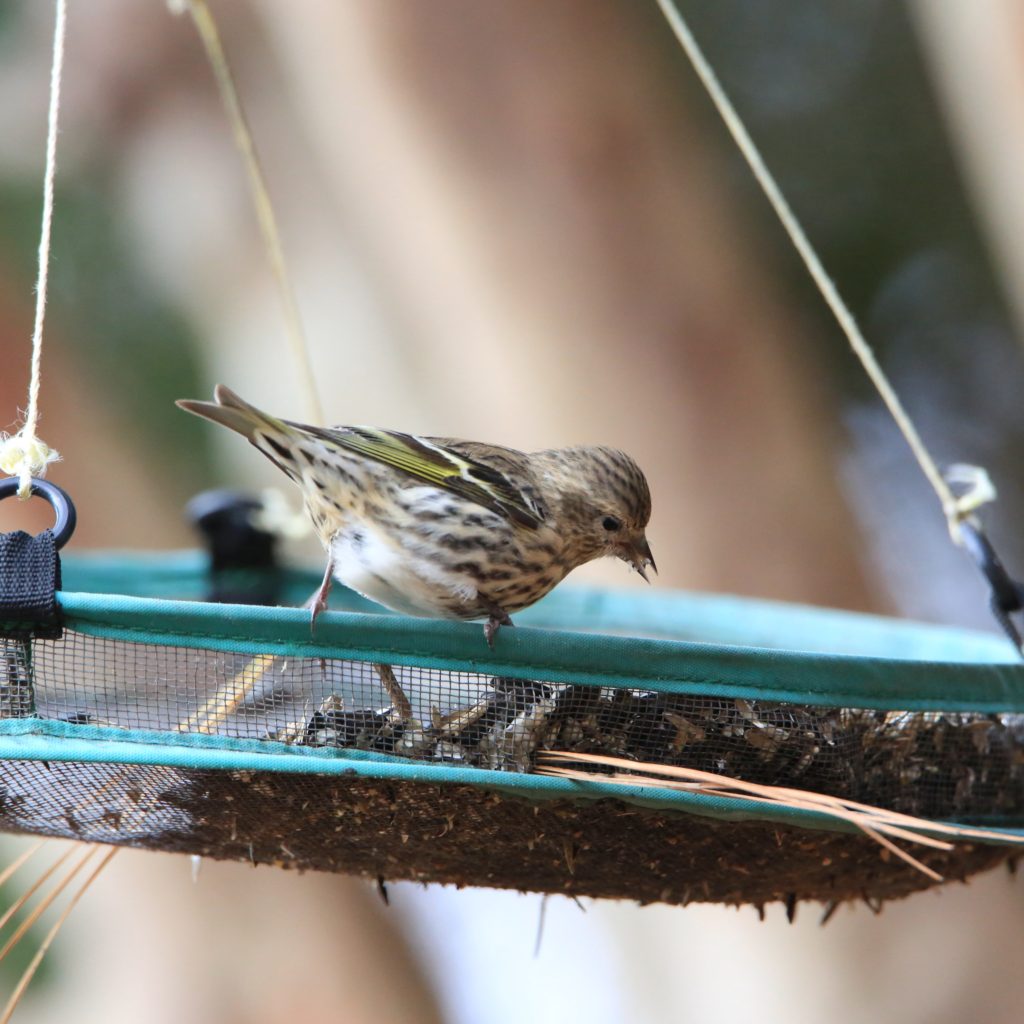
The Pine Siskin
A Pine Siskin is a fun bird to see while bird watching. Below are some tips to help you identify Pine Siskins. We have also put together a list of fun Pine Siskin t-shirts, Pine Siskin bird patches, bird houses, bird feeders, binoculars, stickers and other fun bird watching items.
About Pine Siskins
Pine Siskins are frequent bird feeder visitors monopolizing them over one winter and vanishing completely for the next one. It is a nomadic finch migrating across the continent each winter responding to seed crops. Their feet are better suited for holding on to branch ends rather than hopping around on the ground.
Description and Identification
Pine Siskins are very small songbirds about 4.3 – 5.5 inches long with sharp, pointed bills
and short, notched tails. Their bills are unique among most finches and are considered to be
slenderer than average. While they are in flight, their forked tails and pointed wingtips are
conspicuously visible. Adults are brown on their upperparts and pale on the underparts, with
heavy dark streaking throughout both. They have yellow patches on their wings and tails,
and sometimes also have additional white streaks on their wings. They are unique from
American sparrows by their heavy streaking, slender bills, forked tail, and these colored
patches on their wings. Their wingspan ranges between 7 – 8.7 inches.
Pine Siskin Color Pattern
Pine Siskin bodies are heavily streaked and brown with light yellow edges on its wings. The flashes of yellow can be seen as they burst into flight or during courtship displays.

Pine Siskin Size
They are a group of small songbirds with sharply pointed bills. The unique shape of their bills is slender than those of most finches. Adults have respective measurements of:
- Length 11- 14 cm
- Weight 12 – 18 g
- Wingspan 18 – 22 cm
Pine Siskin Behavior
They are common in bird feeders over the winter season as they cling to branch tips of pine trees and sometimes are seen to hang upside down. They forage in tightly closed flocks.
Pine Siskin Food
Pine Siskins primarily consume seeds of pines and conifers like cedars, larch, hemlock, and
spruce. Deciduous seeds like alder, birch, and maples are also a part of their diet. In urban
areas, they have been found to glean the seeds of grasses, dandelions, sunflowers, and
ragweed. They have also been seen sucking from sapwells created by sapsuckers. Like
many other birds, Pine Siskins require protein-rich diets during breeding, and thus
subsequently forage for insects like spiders and aphids. These insects are also fed to the
young to contribute to their growth before the young and old alike continue to predominantly consume seeds. These birds seem to prefer smaller seeds without tough shells but will
scavenge fragments of larger seeds left by heavier-billed birds.
The Pine Siskin is fond of pine seeds and cedars. They feed on deciduous seeds such as maples. They also feed on young buds of plants and the stem and leaves of weeds and young garden vegetables. During broods, the male feeds the female as she is perched or on the nest.
Pine Siskin Habitat
As their names suggest, Pine Siskins thrive in open conifer forests, with the Northern Pine
forests hosting some of their largest populations. They generally nest in open coniferous or
mixed forests, but can also inhabit parks, cemeteries, and suburban woodlands. Although
they prefer feeding open forest canopies where there are abundant cone seeds, a shortage of
food can also lead them to forage in habitats as diverse as deciduous forests and meadows,
weedy fields, grasslands, roadsides, and backyard gardens and lawns. In urban areas, they
are also drawn to mineral deposits on winter roadbeds, that are salted to melt snow and ice.
Backyard feeders that offer small seeds also attract these birds.
Although the Pine Siskin prefers evergreen forests with open canopies they are quite adaptable as they search for seeds. They forage dense thickets, backyards, and gardens and flock around feeders in suburban areas.
Range and Migration

Pine Siskins are goldfinches that are often confused with sparrows in appearance. These
migratory birds range throughout North America and are confirmed to have three further
subspecies that are found in different regions of the continent. They are known for their
erratic patterns during winter migrations, with inconsistencies in the timings as well as the
size of the flocks that make the migrations. They are spread almost entirely across Canada
and Alaska, along with a few regions of northern and western United States, with the birds
from these areas migrating towards the southern United States and northern Mexico during the
winter. However, some birds that reside along the Rockies in the United States tend to stay
there all year long and only migrate in search of food sources.
Pine Siskin Lifecycle
Females attach the nest to the horizontal end d a branch loosely. The nest is usually well protected by overlying vegetation. Female Pine Siskin lay 3 to 5 eggs in a single breeding season. Incubation takes up to 13 days. Chicks take 13 to 17 days to be strong enough to leave the nest and forage for themselves.
Pine Siskin Nesting
The nest is built by the females on the end of a horizontal branch along the mid-height of a
conifer. These spots need to be concealed by foliage and other branches well but are often
set up in areas where neighboring nests are only a few trees away. The females build a
shallow cup of twigs, grasses, leaves, weed stems, rootlets, bark strips, and lichens using
materials that are often collected by the male. When the structure is made, the inner cup is
lined with fur, feathers, grass, moss, and thistledown. While the nests are warmly insulated
and sufficiently ventilated, their loose attachment to branches makes them susceptible to
strong gusts of winds.
Ornithology
Bird Watching Academy & Camp Subscription Boxes
At Bird Watching Academy & Camp we help kids, youth, and adults get excited and involved in bird watching. We have several monthly subscription boxes that you can subscribe to. Our monthly subscription boxes help kids, youth, and adults learn about birds, bird watching, and bird conservation.
- Kids Bird Watching Monthly Subscription$10.00 / month
- Kid & Adult Bird Watching Starter Pack Subscription$10.00 / month and a $72.00 sign-up fee
- Kids Bird Watching Starter Pack Subscription$10.00 / month and a $19.00 sign-up fee
Bird Watching Binoculars for Identifying Pine Siskins
The most common types of bird watching binoculars for viewing Pine Siskins are 8×21 binoculars and 10×42 binoculars. Bird Watching Academy & Camp sells really nice 8×21 binoculars and 10×42 binoculars. You can view and purchase them here.
- Birding Binoculars$49.99
- Kids Binoculars$13.99
Pine Siskin T-shirts
If you love the Pine Siskin you should purchase a Bird Watching Academy & Camp T-shirt. To help support bird conservation we donate 10 percent to bird conservation activities.
Pine Siskin Iron On Patches
Kids, Youth, and Adults love to collect our Bird Watching Academy & Camp iron on patches. Our bird watching patches help you keep track of the birds you have seen an identified. You can also display the patches on our Bird Watching Academy & Camp banners.
The Pine Siskin is a great iron on patch to start your collection with. The patches are durable and can be sewn on or ironed on to just about anything.
Pine Siskin Stickers
Stickers are a great way for you to display your love for bird watching and the Pine Siskin. We sell a monthly subscription sticker pack. The sticker packs have 12 bird stickers. These sticker packs will help your kids learn new birds every month.
Bird Feeders For Pine Siskin
There are many types of bird feeders. Here are our favorite bird feeders for your backyard. We use all of these bird feeders currently. Kids will have a great time watching birds eat at these bird feeders. Using this collection of bird feeders will provide a wide variety and many types of birds.
Best Bird Houses for Pine Siskin
There are many types of bird houses. Building a bird house is always fun but can be frustrating. These 4 bird houses have become our favorites. Getting a bird house for kids to watch birds grow is always fun. We spent a little extra money on these bird houses but they have been worth the higher price and look great.

















